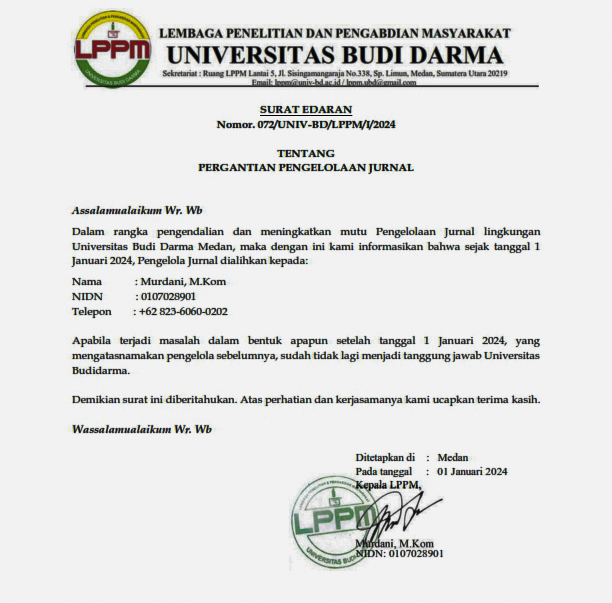Implementasi Algoritma Apriori Dalam Keterkaitan Data Pada Kelangkaan Minyak Goreng
DOI:
https://doi.org/10.30865/json.v3i4.4103Keywords:
Algorithm Apriori, Asosiation Rules, Cooking Oil, SupplyAbstract
The shortage of edible oil has caused the price of oil to be significantly higher than normal, which has led to higher oil prices even in certain regions where there are no edible oil inventories at all (empty warehouses). Due to the phenomenon of cooking oil shortages, many traders sell at high prices using correlation techniques, but they are not suitable. Given so many incidents where traders were selling cooking oil with related technology but not suited to consumers' needs, the authors became interested in analyzing the data connections by applying the a priori algorithm so that the goods paired with the cooking oil were not more useless and can be beneficial to buyers. Transaction data as a reference by a correlation by setting a cut-off value of 15% resulting from scanned transaction data, when buying cooking oil, often from 210 samples at the same time, and the samples taken have too good a number to be used as a correlation to become as they have a leverage value > 1.00 so that they can be used as a reference to arrange the cooking oil supply packaging along with other items.
References
R. Sari and R. Y. Hayuningtyas, “Analisis Keranjang Belanja Pada Transaksi Penjualan Menggunakan Algoritma Apriori,†EVOLUSI J. Sains dan Manaj., vol. 9, no. 1, pp. 46–51, 2021, doi: 10.31294/evolusi.v9i1.9999.
R. D. Lestari et al., “Penerapan Data Mining Untuk Mengetahui Customer Behaviour Toko Artpedia Dengan Menggunakan Application of Data Mining To Know Customer Behaviour,†vol. 7, no. 2, pp. 7140–7146, 2020.
P. Iswandi, I. Permana, and F. N. Salisah, “Penerapan Algoritma Apriori Pada Data Transaksi Penjualan Hypermart Xyz Lampung Untuk Penentuan Tata Letak Barang,†J. Ilm. Rekayasa dan Manaj. Sist. Inf., vol. 6, no. 1, p. 70, 2020, doi: 10.24014/rmsi.v6i1.7613.
I. Qoniah and A. T. Priandika, “Analisis Market Basket Untuk Menentukan Asossiasi Rule Dengan Algoritma Apriori (Studi Kasus: Tb. Menara),†J. Teknol. dan Sist. Inf., vol. 1, no. 2, pp. 26–33, 2020.
H. P. Tambunan and S. Zetli, “Jurnal Comasie,†Comasie, vol. 3, no. 3, pp. 21–30, 2020.
K. K. Widiartha, “Implementasi algorithma apriori untuk analisis keranjang belanja dalam manajemen tata letak produk,†JANAPATI J. Nas. Pendidik. Tek. Inform., vol. 8, pp. 249–260, 2019.
Z. T. Wulansai, “Penerapan Algoritma Apriori untuk Menentukan Tata Letak Menempatkan Barang Dagangan,†J. Gener., vol. 6, no. 1, pp. 45–57, 2022.
W. H. Sirait, “Penerapan Algoritma Apriori dalam Menentukan Pola Penjualan Produk Pertanian,†vol. 2, no. 10, pp. 634–641, 2022, doi: 10.47065/tin.v2i10.1374.
N. Safitri and C. Bella, “PENERAPAN DATA MINING UNTUK ANALISIS POLA PEMBELIAN PELANGGAN ( STUDI KASUS : TOKO DIENGVA BANDAR JAYA ),†vol. 2, no. 1, pp. 1–8, 2022.
R. Abizal, Y. Syahra, and H. Hafizah, “Implementasi Algoritma Apriori Dalam Menganalisis Pola Penjualan Pada Restoran Sederhana,†J-SISKO TECH (Jurnal Teknol. Sist. Inf. dan Sist. Komput. TGD), vol. 5, no. 1, p. 76, 2022, doi: 10.53513/jsk.v5i1.4794.
T. Prasetya, J. E. Yanti, A. I. Purnamasari, and A. R. Dikananda, “Analisis Data Transaksi Terhadap Pola Pembelian Konsumen Menggunakan Metode Algoritma Apriori,†vol. 6, no. 1, pp. 43–52, 2021.
S. D. Saragih, “Analisa Pola Penjualan Alat Pancing Menggunakan Algoritma Apriori,†vol. 3, no. 3, pp. 78–83, 2021.
S. P. Tualeka et al., “IMPLEMENTASI DATA MINING UNTUK MEMPREDIKSI PENJUALAN HOUSEWARE MENGGUNAKAN ALGORITMA APRIORI IMPLEMENTATION OF DATA MINING FOR PREDICTING SALES AND STOCK PLACEMENT AT CV PASTI JAYA HOUSEWARE USING APRIORI,†pp. 115–123, 2021, doi: 10.47002/seminastika.v3i1.258.
A. M. Gumelar and M. Akbar, “Implementasi Data Mining Pengambilan Keputusan Penentuan Korelasi Produk Berdasarkan Pola Transaksi Penjualan Menggunakan Algoritma Apriori Data Mining Implementation Decision Making Determination of Product Correlation Based,†pp. 7–14, 2020.
A. Junaidi, “Implementasi Algoritma Apriori dan FP-Growth Untuk Menentukan Persediaan Barang,†J. Sisfokom (Sistem Inf. dan Komputer), vol. 8, no. 1, pp. 61–67, 2019, doi: 10.32736/sisfokom.v8i1.604.
Downloads
Published
How to Cite
Issue
Section
License

This work is licensed under a Creative Commons Attribution 4.0 International License
Authors who publish with this journal agree to the following terms:
- Authors retain copyright and grant the journal right of first publication with the work simultaneously licensed under Creative Commons Attribution 4.0 International License that allows others to share the work with an acknowledgment of the work's authorship and initial publication in this journal.
- Authors are able to enter into separate, additional contractual arrangements for the non-exclusive distribution of the journal's published version of the work (e.g., post it to an institutional repository or publish it in a book), with an acknowledgment of its initial publication in this journal.
- Authors are permitted and encouraged to post their work online (e.g., in institutional repositories or on their website) prior to and during the submission process, as it can lead to productive exchanges, as well as earlier and greater citation of published work (Refer to The Effect of Open Access).





